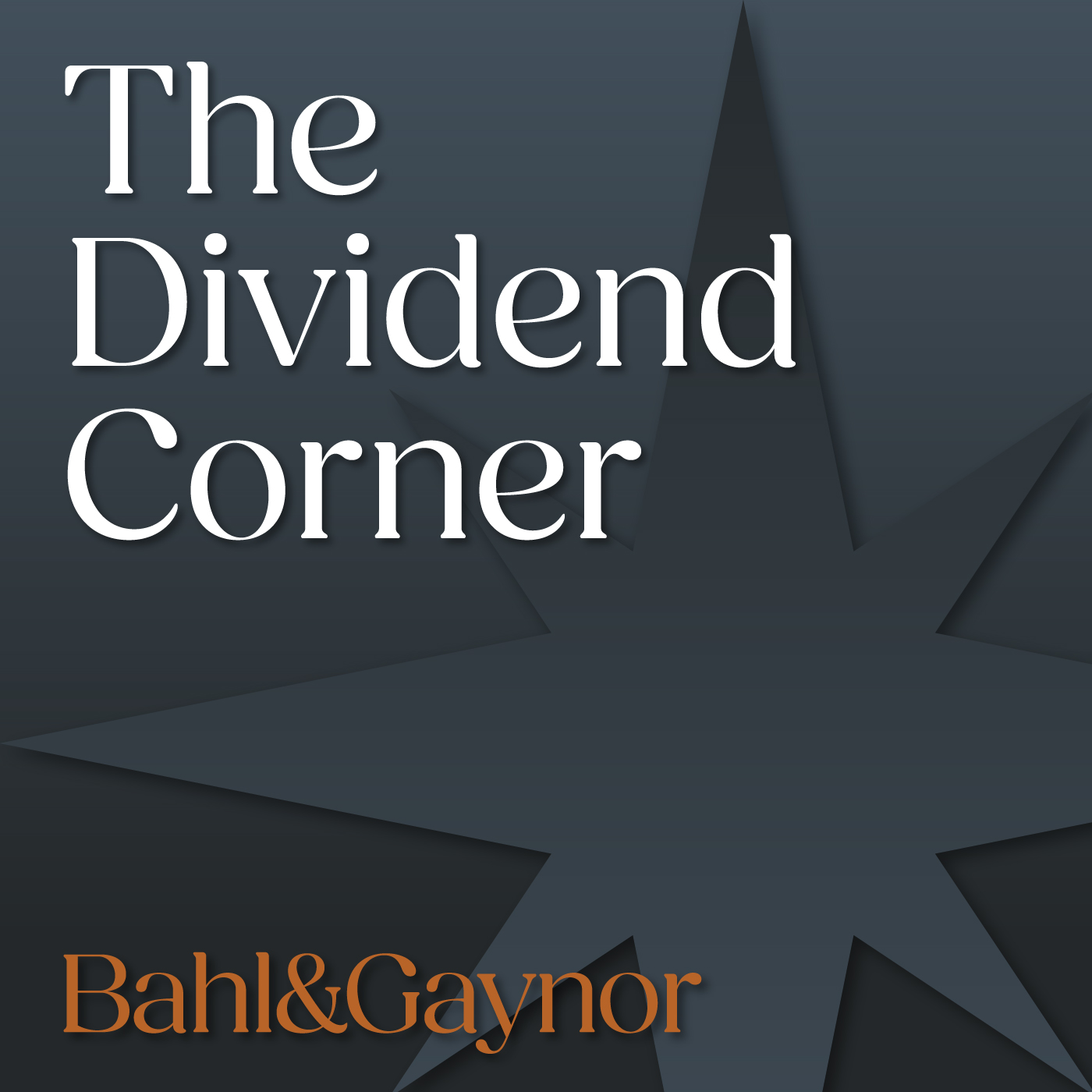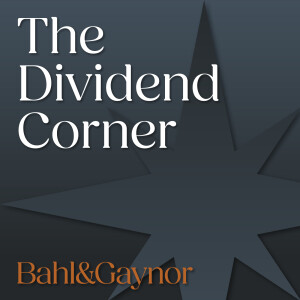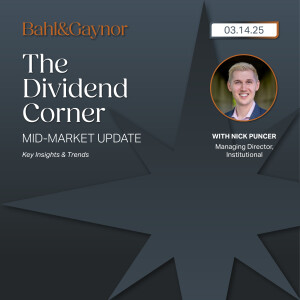
43
Downloads
2
Episodes
The Dividend Corner, a podcast dedicated to providing mid-market updates and key trends impacting financial Investments by our host, Nick Puncer, Portfolio Manager & member of the Bahl & Gaynor Investment Committee. These updates will provide insights into our unique dividend growth investment approach, along with trends in macroeconomic shifts, and the impact on investments. Expert perspectives will take place through each episode, with in-depth conversations brought by the Bahl & Gaynor investment team.
Episodes

Wednesday Apr 16, 2025
The Dividend Corner: Quarter-end Market Update
Wednesday Apr 16, 2025
Wednesday Apr 16, 2025
Hi, I’m Nick Puncer, Portfolio Manager and member of Bahl & Gaynor’s Investment Committee. Welcome to our second episode of The Dividend Corner, following our inaugural episode, which was our mid-quarter update. Today is Monday, March 31, 2025, and we will discuss the first quarter including the current growth scare, Bahl & Gaynor’s positioning, and our outlook.
Since our mid-quarter update, domestic equity markets have remained volatile after sliding as much as 10% during the quarter on growth concerns. This drawdown is perhaps not unsurprising given the combination of high recent returns, lofty valuations, and a fast-changing policy mix.
Bahl & Gaynor’s strategies are designed to provide downside protection, which they did during this quarter. We believe this downside protection is a natural outgrowth of our preference for companies that pay dividends and grow them because the market recognizes the intrinsic quality of these businesses, particularly in times of stress.
As active managers, we believe we can further compound this intrinsic quality, and therefore downside protection, through portfolio diversification and valuation discipline.
In a broader sense, downside protection is important for investors not only because of the recent market drawdown but also because of the current market structure. The slide pictured here illustrates the well-understood dynamic of large-cap concentration increasing over the last decade. But we take this a step further and examine how the downside capture ratio of the largest equity market constituents, pictured at the bottom of the slide, has also changed. This group’s downside capture profile has increased by nearly 50% over the last decade.
Even though the market’s beta will always be one, this does not mean the market has constant volatility. With the high equity returns of the past few years, indeed the last decade, it may be tempting for active managers or investors to mirror index composition. But that action could involve assuming more risk than investors expect or is necessary to achieve their goals. That is why Bahl & Gaynor’s strategies emphasize high active share relative to their index benchmarks, meaning we look very different than the construction of passive indexes.
Because investors have made significant progress against their goals, given the high equity returns of the last decade, a core mandate for our active approach is to avoid setting investors back through exposure to excessive risk and downside volatility.
—
Switching gears to the growth scare at hand. Growth scares occupy a tiring middle ground between the wealth creation of economic expansions and the unsettling wealth diminishment of economic contractions. This fear is perhaps most poignantly elicited in the Atlanta Fed’s GDP Now indicator pictured on this slide, which shows the onset of the growth scare in real time.
Investors are now understandably busied by trying to figure out whether the economy will continue to grow or weaken further. We don’t know which way this growth scare will break, but we also don’t believe that information is necessary for many investors to achieve their goals. Various envisioned futures depend largely on the timeframe. An economic contraction may have a higher probability of occurring near term, but that gives way to a rising potential of expansion further out. The reverse of this is also true. Much of the work to be done by investors concerns managing risk around different time frames. In the near term, if an incremental drawdown is more likely, then downside protection can serve an important purpose. But in the long term, inflation and preserving investor purchasing power are probably the risks of greatest concern.
Bahl & Gaynor’s investment approach attempts to balance the various timeframes investors must navigate:
- The downside protection we seek to provide is the desired outcome of the fact pattern we prefer for fundamental investment. It should be predictably present in the near term when needed, as it has been amid this current growth scare.
- But our commitment to being a fully invested, diversified, equity-only manager serves the longer-term objective of inflation protection both through growing investment income and capturing the equity risk premium.
We believe exposure to equities with less volatility than the market, particularly downside volatility, is a potentially useful component of any investor's portfolio.
—
Much of our commentary has been philosophical, which we view as appropriate given the inherent emotion of a growth scare. But we also believe there are more tangible takeaways worth highlighting:
First, diversification balanced with conviction is an important competitive advantage of active management. This speaks to the market concentration and downside capture profile of the current market structure we shared earlier. Letting risk exposures float freely – as in passive index construction – can yield volatile outcomes for investors when economic fundamentals or even sentiment and expectations shift. While operating a diversified portfolio may not deliver maximum near-term absolute return, we do think it can provide competitive returns adjusted for risk, which we believe suits the temperament of human clients well. Our efforts to manage concentration risk in our portfolios have paid off in terms of providing downside protection and potentially capturing the opportunities available through rotating proceeds from high-expectation wins to low-expectation opportunities.
Second, opportunities likely exist where most investors are not focused. Strong market returns of the last few years have been concentrated in sectors receiving significant investor attention, like the Information Technology and Consumer Discretionary sectors. While exposure to secular growth patterns in these sectors is important, and something we possess across our strategies, we also believe opportunities can be found in unloved sectors where many investors have allocated little attention. Lately, these might include the Consumer Staples and Health Care sectors, or Energy and Financials before that. Many of these unloved sectors have provided alpha generation and downside protection amid the recent growth scare. In turn, we believe some of the recently dented sectors that had captured much investor attention in prior years may possess their own opportunities that we are currently investigating.
Third, uncertainty in the market does not abate – it just shifts around. The policy uncertainty, partly to blame for worrying investors this quarter, may never return to zero. Indeed, believing it was zero to start is likely a false premise. Given this, it makes sense to pay close attention to fundamental characteristics that position business models to thrive in the broadest range of potential outcomes. That is why the work of fundamental analysis is a critical tool Bahl & Gaynor constantly utilize to proactively manage portfolio risk.
—
We are often asked about our broader thoughts and perspectives outside of our focused fundamental dividend growth philosophy. To close out this quarter’s commentary, we want to share some of these thoughts, ordered from the nearest term to the most secular in nature:
- Sentiment has shifted massively over the last quarter, almost a complete 180° from the prior quarter and two years. This almost inevitably means sentiment has overshot in terms of bearishness and may begin to recover before long. So, human sentiment is volatile and unpredictable, which is why it’s important to be invested and stay invested; that is what permits compounding.
- But, sentiment improving and some market recovery do not necessarily mean market volatility will settle back down. There remains a tug of war between growth-negative and growth-positive policy narratives. Timing, sequencing, and magnitude of these policies will eventually impact fundamentals, but specifics won’t be known for some time. In the face of this ongoing uncertainty and paying deference to the importance of being invested and staying invested – being diversified while invested acknowledges and addresses the presence of risk, which we think of as the possibility that more things can occur than will occur.
- It’s not lost on us that “soft data” responds quickly to shocks, but “hard data” can take longer to register a response. This is both a good and a bad thing. A good thing if policy volatility quickly settles down, then real economic damage could be minimal. A bad thing if policy volatility remains elevated and important economic decisions are put off, stalling growth via a negative feedback loop. Focusing on business model resilience is critical given the spectrum of potential economic outcomes.
- Benchmarks can be useful to gauge variables affecting equity returns like valuation, earnings growth, and participation. But benchmarks can also possess serious flaws, like susceptibility to excessive investor optimism or concentration, and reflect the past perhaps more than the future. For human investors, the best benchmark is likely simply achieving one’s goals. This often has more to do with a well-considered plan regarding risk than the pursuit of only surface-level absolute return. Take time to revisit goals and re-underwrite portfolio positioning according to risk tolerance and goals.
- Pictured in this slide, the contribution to equity return has been heavily skewed towards price return rather than dividend return in the last 15 years. This differs significantly from the last century of market history. It is not unprecedented to have price return-heavy regimes, but these are often followed by dividend return-heavy spans. Many of the topics causing investors concern today, like inflation and hyper-globalization, are new risks that differ considerably from the risks faced over the prior 15 years. These risks will likely have different impacts on the mix of dividend and price return comprising total equity return over the next 15 years. Consider dividends as a potential return source to address secular risks.
The current growth scare is another reminder of the uncertainty equity investors must endure to earn the risk premium associated with the asset class. But investors are not powerless in controlling the risk profile of their portfolios to align with their temperament and needs. We are grateful for the opportunity to share our results and thoughts about these topics with investors we currently serve, and those we hope to serve in the future. Thank you for your time in listening today, and please do not hesitate to reach out to us through your local Institutional Portfolio Consultant, our website, or by telephone. We look forward to continuing to serve you.
Disclosure:
The information presented in this commentary is for informational purposes only and should not be construed as investment advice or a recommendation to buy or sell any security. This commentary does not create a fiduciary relationship or obligation between Bahl & Gaynor and any recipient.
Investing involves risk, including the possible loss of principal. No investment strategy, including those designed to provide downside protection or dividend growth, can guarantee positive returns or eliminate risk. Diversification does not ensure a profit or protect against loss in declining markets. Past performance is not indicative of future results.
The views expressed in this commentary are those of the speaker and may not necessarily reflect the views of Bahl & Gaynor. Market conditions can change rapidly, and any opinions or projections are based on current information and assumptions that may change without notice. Actual results may differ materially due to various factors, including market conditions, economic developments, and unforeseen events.
This commentary may contain forward-looking statements, which are based on current expectations, estimates, forecasts, and assumptions that involve risks and uncertainties. Actual outcomes and results may differ materially from those expressed or implied in any forward-looking statements due to various factors, including but not limited to changes in economic conditions, interest rates, market volatility, and regulatory developments. Bahl & Gaynor assumes no obligation to update any forward-looking statements.
References to benchmarks and market indices are for illustrative purposes only and do not imply that Bahl & Gaynor’s strategies will achieve similar results or outperform. Benchmark and index comparisons are not intended to suggest that any Bahl & Gaynor strategy will outperform or achieve similar results. Investors should carefully consider their objectives, risk tolerance, and investment time horizon before making any investment decisions.
Any references to specific securities are for educational purposes only and should not be considered a solicitation, recommendation, or endorsement.
Bahl & Gaynor is a registered investment adviser with the Securities and Exchange Commission (SEC). All discussions in this commentary are subject to the firm’s disclosure documents, including Form ADV Part 2A and Part 2B, which are available upon request. Bahl & Gaynor provides investment advisory services in accordance with applicable laws and regulations.

Tuesday Apr 08, 2025
First Quarter 2025 Mid-Quarter Update
Tuesday Apr 08, 2025
Tuesday Apr 08, 2025
Hi, I’m Nick Puncer, Portfolio Manager and member of Bahl & Gaynor’s Investment Committee. Today is Friday, March 7, 2025, so we are more than 2/3 of the way through the first quarter, and we wanted to provide investors with our thoughts about the year to date and outlook.
The quarter started with optimism regarding economic growth, which is understandable given the strong economic profile of the last two years and the substantial equity returns this fact pattern has supported.
But challenges have mounted, including:
- The emergence of DeepSeek as a potentially lower-cost disruptor of the US artificial intelligence ecosystem,
- Attempts to reduce fiscal spending via DOGE and congressional action; and,
- Fluid tariff policy enactment across major US trading partners.
These factors have not yet significantly affected growth, inflation, or other economic variables, but policy volatility has weighed on investor sentiment. This can eventually impact investment decisions and promote elevated volatility in equity markets.
Friday, February 21, seemed to be the first day of market action reflecting the emergence of a “growth scare”:
- Market action that day carried a distinctly defensive market tone,
- The volatile trading pattern has generally been sustained through February and into March,
- This has generally benefited our high-quality, dividend growth approach, leaving all four marketed strategies ahead of their respective benchmarks for the YTD period through March 7.
Our Investment Committee views these periods of elevated volatility as opportunistic because they generally produce investor over-reactions, which can lead to assets becoming mis-priced:
- In particular, we have been focused on the opportunity set in the Health Care and Consumer Staples sectors, where investor expectations appear to be quite low, yet business models exist within these sectors that fit our quality and shareholder capital return criteria.
- We are also aware of sectors where expectations may be lofty coming into this period of volatility, like Information Technology and Consumer Discretionary. This is not to say we are downbeat on the categories as a whole, but funding opportunistic asset mis-pricings in beaten-down sectors is often best achieved by sourcing funds from sectors where high expectations may be at risk of disappointing investors.
Taking a step back in terms of market outlook, we believe the last two years of healthy equity returns were largely driven by the upside surprise of avoiding recession. We suspect the avoidance of recession was a base case expectation for investors entering this year, which is partly evidenced by equity index targets published by the Street to begin the year that were largely ahead of levels achieved by the end of 2024.
All of this is to say that continued disruption to the narrative of a “no recession scenario” could sustain volatility like what we are seeing now.
To manage this risk, we focus on owning reasonably priced assets, with a low-volatility source of return in the form of dividends and dividend growth, and underlying business models capable of compounding throughout economic cycles.
We do think that active management possesses an advantage of choosing risk exposures in a volatile environment, and we do see ample opportunity for our style of investing to add value across the market cap range.
On that note, we will conclude by inviting you to review two recent and brief white paper publications: “Big Reasons to Think Small – Volume 2,” and “Market Concentration: At the Tipping Point?” on our website under the Insights tab.
The first publication outlines the opportunity for owning dividend growth equities in the small and mid-cap space.
The second paper takes a historical view of concentration and diversification cycles in equity markets and the distinctly different return profiles in each of these regimes.
Thank you for your time in listening today, and please do not hesitate to reach out to us through your local Institutional Portfolio Consultant, our website, or by telephone. We look forward to serving you.
Disclosure:
Please note that the information provided in this update is for informational purposes only and does not constitute investment advice or a recommendation by Bahl & Gaynor.
The views expressed in this update are those of the speaker and may not reflect the views of Bahl & Gaynor. Market conditions can change rapidly, and past performance is not indicative of future results.
Before making any investment decisions, please consult with a qualified financial professional to ensure the information is appropriate for your individual circumstances.
Bahl & Gaynor is a registered investment adviser with the Securities and Exchange Commission (SEC), and all discussions in this update are subject to the firm’s disclosure documents, including Form ADV Part 2A and Part 2B, which are available upon request.
This is not an offer to buy or sell any securities or investments. Any examples or information related to specific securities are for educational purposes and should not be considered a solicitation or recommendation.
